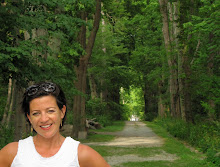
Black Locusts are wild-growing plants. Their habit is informal and asymmetrical and they are fairly short-lived (especially for such a hard-wooded plant). The wood, in addition to being very durable, is rot-resistant and has an agricultural history of being used as fenceposts.
I've been misinforming my students that this tree is in the Leguminosae family. It turns out the family has been subdivided into four distinct families and now Robinia is in the Fabaceae, or Pea, family. The unique thing about most Fabaceous plants is that the roots can fix nitrogen.
But, the most remarkable thing about this plant, to me, is the bark. Cinnamon-colored at the deepest parts of its fissures, and a light, stony gray on the outer layers, the bark looks more like petrified driftwood than part of a living tree. It's wild and abandoned-looking.
 When it leafs out, the texture softens significantly and the grayish-blue foliage reminds me of European landscape paintings from 17th and 18th Centuries, like this Lorrain:
When it leafs out, the texture softens significantly and the grayish-blue foliage reminds me of European landscape paintings from 17th and 18th Centuries, like this Lorrain:

1 comment:
Hi Jennifer, I posted a #followfriday for newyorkplants just now..... and I added you to my google reader.
(couldn't 'direct message' because you don't appear to be following me on twitter) Have a lovely day :-))
Post a Comment